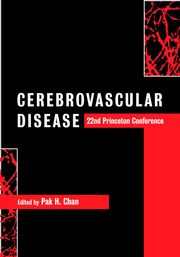Book contents
- Frontmatter
- Contents
- List of contributors
- Preface
- Acknowledgments
- Part I Special lectures
- Part II Oxidative stress
- Part III Apoptosis
- Part IV Hot topics
- Part V Hemorrhage, edema and secondary injury
- Part VI Inflammation
- Part VII Gene transfer and therapy
- Part VIII Neurogenesis and plasticity
- Part IX Magnetic resonance imaging in clinical stroke
- 28 Magnetic resonance imaging in stroke trials
- 29 Disappearing deficits and disappearing lesions: diffusion/perfusion MRI in transient ischemic attack and intra-arterial thrombolysis
- 30 Diffusion and perfusion magnetic resonance imaging in the evaluation of acute ischemic stroke
- 31 Early recanalization in acute ischemic stroke saves tissue at risk defined by stroke magnetic resonance imaging
- Part X Risk factors, clinical trials and new therapeutic horizons
- Index
- Plate section
28 - Magnetic resonance imaging in stroke trials
from Part IX - Magnetic resonance imaging in clinical stroke
Published online by Cambridge University Press: 02 November 2009
- Frontmatter
- Contents
- List of contributors
- Preface
- Acknowledgments
- Part I Special lectures
- Part II Oxidative stress
- Part III Apoptosis
- Part IV Hot topics
- Part V Hemorrhage, edema and secondary injury
- Part VI Inflammation
- Part VII Gene transfer and therapy
- Part VIII Neurogenesis and plasticity
- Part IX Magnetic resonance imaging in clinical stroke
- 28 Magnetic resonance imaging in stroke trials
- 29 Disappearing deficits and disappearing lesions: diffusion/perfusion MRI in transient ischemic attack and intra-arterial thrombolysis
- 30 Diffusion and perfusion magnetic resonance imaging in the evaluation of acute ischemic stroke
- 31 Early recanalization in acute ischemic stroke saves tissue at risk defined by stroke magnetic resonance imaging
- Part X Risk factors, clinical trials and new therapeutic horizons
- Index
- Plate section
Summary
Introduction
The disappointingly slow progress in developing effective therapies for ischemic stroke has led to a re-evaluation of the strategies for stroke drug development and the methods used in clinical trials. Magnetic resonance imaging (MRI) techniques have been proposed and have begun to be used in stroke trials as a means of optimizing patient selection and as a direct measure of the effect of treatments on the brain.
One objective in all clinical trials is the selection of a sample sufficiently homogeneous to reduce the statistical variance of the data, thereby optimizing the sensitivity of the design to detecting a therapeutic response, while remaining representative of the population of interest. Ischemic stroke trials have traditionally sought to limit the range of disease studied according to one or more of several dimensions, such as clinical severity at the time of enrollment, exclusion of non-ischemic causes for the clinical syndrome, lesion location and vascular territory, stroke mechanism and comorbidities. In the modern era of stroke clinical trials these dimensions have been assessed by clinical criteria at the bedside usually aided by the exclusion of cerebral hemorrhage or other non-ischemic pathology by non-contrast computed tomography (CT) scan as the only imaging tool required.
- Type
- Chapter
- Information
- Cerebrovascular Disease22nd Princeton Conference, pp. 339 - 352Publisher: Cambridge University PressPrint publication year: 2002
- 1
- Cited by



